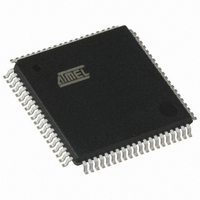AT89C5132-ROTUL Atmel, AT89C5132-ROTUL Datasheet - Page 34

AT89C5132-ROTUL
Manufacturer Part Number
AT89C5132-ROTUL
Description
IC 8051 MCU FLASH 64K USB 80TQFP
Manufacturer
Atmel
Series
AT89C513xr
Specifications of AT89C5132-ROTUL
Core Processor
C52X2
Core Size
8-Bit
Speed
20MHz
Connectivity
IDE/ATAPI, I²C, MMC, PCM, SPI, UART/USART, USB
Peripherals
I²S, POR, WDT
Number Of I /o
44
Program Memory Size
64KB (64K x 8)
Program Memory Type
FLASH
Eeprom Size
4K x 8
Ram Size
2.25K x 8
Voltage - Supply (vcc/vdd)
2.7 V ~ 3.3 V
Data Converters
A/D 2x10b
Oscillator Type
Internal
Operating Temperature
-40°C ~ 85°C
Package / Case
80-TQFP, 80-VQFP
Cpu Family
89C
Device Core
8051
Device Core Size
8b
Frequency (max)
40MHz
Interface Type
IDE/SPI/UART/USB
Total Internal Ram Size
2.25KB
# I/os (max)
44
Number Of Timers - General Purpose
2
Operating Supply Voltage (typ)
3V
Operating Supply Voltage (max)
3.3V
Operating Supply Voltage (min)
2.7V
On-chip Adc
2-chx10-bit
Instruction Set Architecture
CISC
Operating Temp Range
-40C to 85C
Operating Temperature Classification
Industrial
Mounting
Surface Mount
Pin Count
80
Package Type
TQFP
Package
80TQFP
Family Name
89C
Maximum Speed
40 MHz
Operating Supply Voltage
3 V
Data Bus Width
8 Bit
Number Of Programmable I/os
44
Number Of Timers
2
Maximum Clock Frequency
20 MHz
Data Ram Size
2304 B
Mounting Style
SMD/SMT
A/d Bit Size
10 bit
A/d Channels Available
2
Height
1.45 mm
Length
14.1 mm
Maximum Operating Temperature
+ 85 C
Minimum Operating Temperature
- 40 C
Supply Voltage (max)
3.3 V
Supply Voltage (min)
2.7 V
Width
14.1 mm
For Use With
AT89OCD-01 - USB EMULATOR FOR AT8XC51 MCU
Lead Free Status / RoHS Status
Lead free / RoHS Compliant
Available stocks
Company
Part Number
Manufacturer
Quantity
Price
10. Interrupt System
10.1
34
Interrupt System Priorities
AT89C5132
The AT89C5132, like other control-oriented computer architectures, employ a program interrupt
method. This operation branches to a subroutine and performs some service in response to the
interrupt. When the subroutine terminates, execution resumes at the point where the interrupt
occurred. Interrupts may occur as a result of internal AT89C5132 activity (e.g., timer overflow) or
at the initiation of electrical signals external to the microcontroller (e.g., keyboard). In all cases,
interrupt operation is programmed by the system designer, who determines priority of interrupt
service relative to normal code execution and other interrupt service routines. All of the interrupt
sources are enabled or disabled by the system designer and may be manipulated dynamically.
A typical interrupt event chain occurs as follows:
1. An internal or external device initiates an interrupt-request signal. The AT89C5132, latch
2. The priority of the flag is compared to the priority of other interrupts by the interrupt han-
3. This signals the instruction execution unit to execute a context switch. This context
4. The software service routine executes assigned tasks and as a final activity performs a
Table 32. Interrupt System Signals
Six interrupt registers are used to control the interrupt system. Two 8-bit registers are used to
enable separately the interrupt sources: IEN0 and IEN1 registers (see Table 35 and Table 36).
Four 8-bit registers are used to establish the priority level of the sources: IPH0, IPL0, IPH1 and
IPL1 registers (see Table 10-1 to Table 39).
Each of the interrupt sources on the AT89C5132 can be individually programmed to one of four
priority levels. This is accomplished by one bit in the Interrupt Priority High registers (IPH0 and
IPH1) and one bit in the Interrupt Priority Low registers (IPL0 and IPL1). This provides each
interrupt source four possible priority levels according to Table 33.
Signal
KIN3:0
Name
INT0
INT1
this event into a flag buffer.
dler. A high priority causes the handler to set an interrupt flag.
switch breaks the current flow of instruction sequences. The execution unit completes
the current instruction prior to a save of the program counter (PC) and reloads the PC
with the start address of a software service routine.
RETI (return from interrupt) instruction. This instruction signals completion of the inter-
rupt, resets the interrupt-in-progress priority and reloads the program counter. Program
operation then continues from the original point of interruption.
Type
I
I
I
Description
External Interrupt 0
See Section "External Interrupts", page 37.
External Interrupt 1
See Section “External Interrupts”, page 37.
Keyboard Interrupt Inputs
See Section “Keyboard Interface”, page 152.
4173E–USB–09/07
Alternate
Function
P1.3:0
P3.2
P3.3














